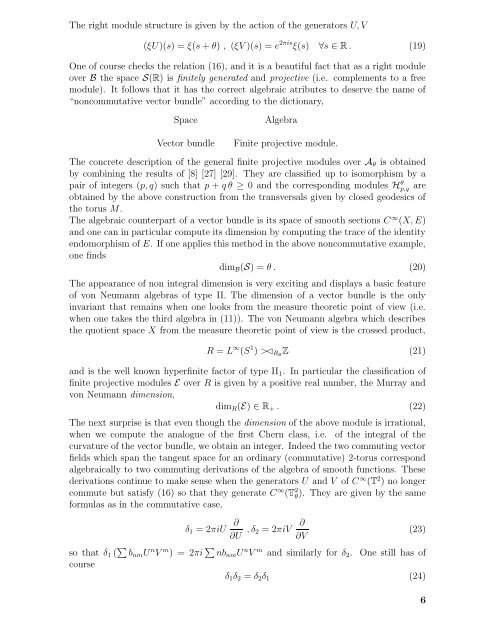Alain Connes (pdf)
Alain Connes (pdf)
Alain Connes (pdf)
You also want an ePaper? Increase the reach of your titles
YUMPU automatically turns print PDFs into web optimized ePapers that Google loves.
The right module structure is given by the action of the generators U, V<br />
(ξU)(s) = ξ(s + θ) , (ξV )(s) = e 2πis ξ(s) ∀s ∈ R . (19)<br />
One of course checks the relation (16), and it is a beautiful fact that as a right module<br />
over B the space S(R) is finitely generated and projective (i.e. complements to a free<br />
module). It follows that it has the correct algebraic atributes to deserve the name of<br />
“noncommutative vector bundle” according to the dictionary,<br />
Space<br />
Vector bundle<br />
Algebra<br />
Finite projective module.<br />
The concrete description of the general finite projective modules over A θ is obtained<br />
by combining the results of [8] [27] [29]. They are classified up to isomorphism by a<br />
pair of integers (p, q) such that p + q θ ≥ 0 and the corresponding modules H θ p,q are<br />
obtained by the above construction from the transversals given by closed geodesics of<br />
the torus M.<br />
The algebraic counterpart of a vector bundle is its space of smooth sections C ∞ (X, E)<br />
and one can in particular compute its dimension by computing the trace of the identity<br />
endomorphism of E. If one applies this method in the above noncommutative example,<br />
one finds<br />
dim B (S) = θ . (20)<br />
The appearance of non integral dimension is very exciting and displays a basic feature<br />
of von Neumann algebras of type II. The dimension of a vector bundle is the only<br />
invariant that remains when one looks from the measure theoretic point of view (i.e.<br />
when one takes the third algebra in (11)). The von Neumann algebra which describes<br />
the quotient space X from the measure theoretic point of view is the crossed product,<br />
R = L ∞ (S 1 ) >✁ Rθ Z (21)<br />
and is the well known hyperfinite factor of type II 1 . In particular the classification of<br />
finite projective modules E over R is given by a positive real number, the Murray and<br />
von Neumann dimension,<br />
dim R (E) ∈ R + . (22)<br />
The next surprise is that even though the dimension of the above module is irrational,<br />
when we compute the analogue of the first Chern class, i.e. of the integral of the<br />
curvature of the vector bundle, we obtain an integer. Indeed the two commuting vector<br />
fields which span the tangent space for an ordinary (commutative) 2-torus correspond<br />
algebraically to two commuting derivations of the algebra of smooth functions. These<br />
derivations continue to make sense when the generators U and V of C ∞ (T 2 ) no longer<br />
commute but satisfy (16) so that they generate C ∞ (T 2 θ ). They are given by the same<br />
formulas as in the commutative case,<br />
δ 1 = 2πiU<br />
∂<br />
∂U , δ 2 = 2πiV<br />
so that δ 1 ( ∑ b nm U n V m ) = 2πi ∑ nb nm U n V m and similarly for δ 2 . One still has of<br />
course<br />
δ 1 δ 2 = δ 2 δ 1 (24)<br />
∂<br />
∂V<br />
(23)<br />
6

















